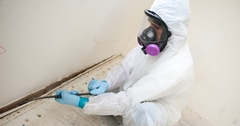Blog Post
How To Remove Black Mold and Why You Don’t Want to Do It Yourself

If you find toxic black mold in your home, do not disturb it. It is extremely risky to try to remove toxic black mold yourself. Instead, talk to a restoration service as soon as possible. A professional mold removal service is experienced in removing toxic black mold and uses the proper methods to contain the spread of spores and mycotoxins during the remediation process.
Main Steps For Mold Removal
- Wear protective equipment
- Respirator mask
- Eye protection
- Gloves
- Clothing that completely covers you and can be disposed of
- Seal rooms with plastic sheets to contain mold spores
- Create negative pressure by running a fan blowing out a window
- Use mold removal products such as…
- Bleach
- Borax
- Vinegar
- Ammonia
- Completely clean mold from non-porous objects. Porous objects may need to be thrown out if mold can't be removed.
- HEPA vacuum the area with a professional grade vacuum.
- Seal moldy objects in plastic bags and dispose of them.
This is not a job for an average or even handy homeowner, given the chemicals involved and the setup and tear down required. Add in the chance to breathe all of this in and it's easy to figure out that you need a professional.
Remove Toxic Black Mold Quickly
As soon as you find toxic black mold in your home, you should take steps to have the mold removed. Every day you spend in an environment with toxic black mold is potentially causing you long-term chronic health problems and permanent damage. Don't underestimate the effect toxic black mold can have on your health. Toxic black mold can cause problems such as mental impairment, breathing difficulty, damage to internal organs and sometimes even death.
Moving During Toxic Black Mold Removal
Experts recommend that if you have toxic black mold in your home, it's best to move to temporary accommodations until it has been removed, especially if you are suffering toxic symptoms. Ideally, you should only return to your home after a professional toxic black mold removal service has completely eliminated the problem. Keep in mind that there is a possibility that belongings may also contain mycotoxins from the toxic black mold.
Removal of Toxic Black Mold Mycotoxins
Mycotoxins are extremely small which makes them much harder to remove than typical mold spores. In addition, mycotoxins are very resilient and can take several years for them to break down naturally. For these reasons, it's important that toxic black mold removal be performed properly to contain mycotoxins from spreading throughout the home.
Testing and Identifying Toxic Black Mold
If you think you have found toxic black mold growing in your home, you should have it professionally tested. In this way, you can be absolutely certain that it is a mycotoxin-producing toxic mold or some other toxic mold species. Once you've confirmed the mold is toxic you should talk to a professional mold removal service as soon as possible. If the mold is not toxic, you can decide whether or not you wish to remove it yourself.
Toxic Black Mold Inspection
If you think you might have toxic black mold in your home but haven't found the mold colony, then you may want to have a toxic black mold inspection performed by a professional mold inspector. Mold inspectors use both their experience and sophisticated equipment to find any and all hidden mold, with minimal disturbance to your home. With a professional mold inspection, you can feel confident that any mold in your home will be found.
Signs of Toxic Black Mold
If you are suffering toxic symptoms, this could be a big clue that you may have toxic black mold in your home. The symptoms from toxic black mold are much more severe than the allergic reactions caused by common non-toxic mold.
Toxic black mold also needs materials to be very wet for at least a week before it can begin to grow. If you've experienced a flood or a large water leak that went unnoticed, then there is an increased possibility that toxic black mold has started to colonize.
A moldy odor can be another clue that mold is growing somewhere hidden out of sight. Another sign of moisture problems that could lead to toxic black mold growth are surface abnormalities like peeling, bubbling or cracking paint or wallpaper. If walls are bowed, bulging or feel damp it probably means moisture has gotten into them creating the perfect environment for mold to colonize.
A professional mold inspector has the tools to access these hidden regions of your home to uncover any toxic black mold colonies. If toxic black mold is confirmed, he/she can help guide you through the next steps of black mold removal and remediation.
A good restoration company can make sure your water or wind or fire damage is fixed right and that you're out of pocket damage liability is kept to a minimum. We've helped numerous home and business owners and they and their insurance company always appreciate our surgical approach to restoration!
 About 1st Call Disaster Services
About 1st Call Disaster Services
Property disaster is disastrous and emotionally unsettling. At 1st Call Disaster Services, our commitment is to helping regain your sense of security while rebuilding your surroundings. Our team members are not only professionally trained in the latest restoration technologies, techniques and procedures, they are also compassionate toward families and businesses having to endure the aftermath of a devastating situation. We are licensed and insured, specializing in all areas of property damage mitigation and our promise is to do whatever it takes to help you get your life back in order as quickly as possible.
What We Deliver…
- A team of trained and certified technicians
- The latest mitigation technology and procedures
- A strict code of ethics
- Round the clock availability 24/7
- 2 hour emergency response time
- A commitment to save and restore property
- Continual communication with all parties involved in the claim
- Professional, efficient, and exemplary service